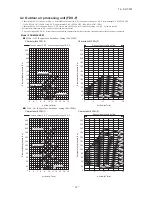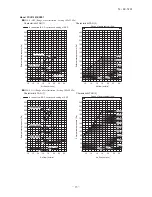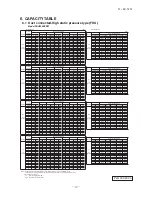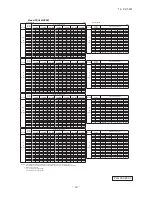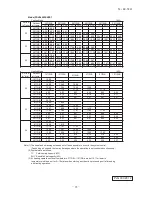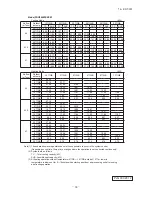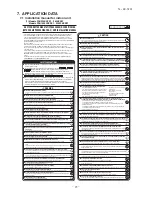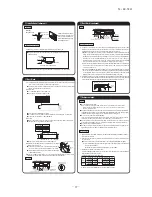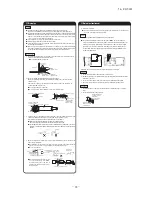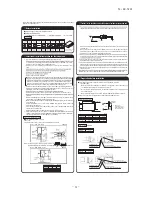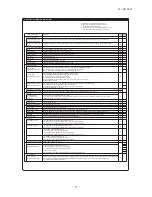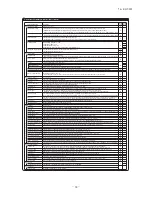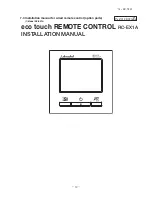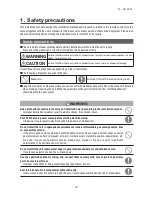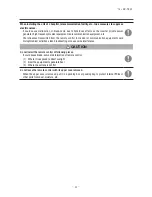
-
-
'14 • KX-T-222
⑤
Installation of indoor unit
Insulation material
295-325
⑥
Duct Work (continued)
⑥
Duct Work
①
A corrugated board (for preventing sputtering) is attached to the main body of the air-conditioner
(on the outlet port). Do not remove it until connecting the duct.
●
An air filter can be provided on the main body of the air-conditioner (on the inlet port). Remove
it when connecting the duct on the inlet port.
②
Blowout duct
●
Use rectangular duct to connect with unit.
●
Duct size for each unit is as shown below.
●
Duct should be at their minimum length.
●
We recommend to use sound and heat insulated duct to prevent it from condensation.
●
Connect duct to unit before ceiling attachment.
③
Inlet port
●
When connecting the duct to the inlet port, remove the air filter if it is fitted to the inlet port.
●
Inlet port size for each unit is as shown below.
●
Make sure to insulate the duct to prevent dewing on it.
④
Install the specific blowout duct in a location where the air will
circulate to the entire room.
●
Conduct the installation of the specific blowout hole and the
connection of the duct before attaching them to the ceiling.
●
Insulate the area where the duct is secured by a band for dew
condensation prevention.
⑤
Make sure provide an inspection hole on the ceiling. It is indispensable to service electric
equipment, motor, functional components and cleaning of heat exchanger.
Secure with a band, etc.
Blowout
duct
Air conditioner unit
Ceiling suriace
Suction hole
(marketed item)
(with air filter)
Inspection hole
Suction duct
(marketed item)
A
Blow outlet
Blowout duct
(optional or marketed item)
①
If a duct is not provided at the suction side but it is substituted with the space over the ceiling,
humidity in the space will increase by the influence of capacity of ventilation fan, strength of
wind blowing against the out door air louver, weather (rainy day) and others.
a)Moisture in air is likely to condense over the external plates of the unit and to drip on the
ceiling. Unit should be operated under the conditions as listed in the above table and within
the limitation of wind volume. When the building is a concrete structure, especially immedi-
ately after the construction, humidity tends to rise even if the space over the ceiling is not
substituted in place of a duct. In such occasion, it is necessary to insulate the entire unit with
glass wool (25mm). (Use a wire net or equivalent to hold the glass wool in place.)
b)It may run out the allowable limit of unit operation (Example: When outdoor air temperature
is 35°C DB, suction air temperature is 27°C WB) and it could result in such troubles as
compressor overload, etc..
c)There is a possibility that the blow air volume may exceed the allowable range of operation
due to the capacity of ventilation fan or strength of wind blowing against external air louver
so that drainage from be heat exchanger may fall to reach the drain pan but leak outside
(Example: drip on to the ceiling) with consequential water leakage in the room.
②
If vibration damping is not conducted between the unit and the duct, and between the unit and
the slab, vibration will be transmitted to the duct and vibration noise may occur. Also, vibration
may be transmitted from the unit to the slab. Vibration damping must be performed.
Bad example of duct work
Bad example of duct work
For ventilation
Louver to
outdoor air
⑦
Refrigerant pipe
Caution
●
Use the new refrigerant pipe.
When re-using the existing pipe system for R22 or R407C, pay attention to the following items.
・
Change the flare nuts with the attached ones (JIS category 2), and reprocess the flare parts.
・
Do not use thin-walled pipes.
●
Use phosphorus deoxidized copper alloy seamless pipe (C1220T specified in JIS H 3300) for refrigeration pipe installation.
In addition, make sure there is no damage both inside and outside of the pipe, and no harmful
substances such as sulfur, oxide, dust or a contaminant stuck on the pipes.
●
Do not use any refrigerant other than R410A.
Using other refrigerant except R410A (R22 etc.) may degrade inside refrigeration oil. And air getting into
refrigeration circuit may cause over-pressure and resultant it may result in bursting, etc.
●
Store the copper pipes indoors and seal the both end of them until they are brazed in order to avoid any dust, dirt or
water getting into pipe. Otherwise it will cause degradation of refrigeration oil and compressor breakdown, etc.
●
Use special tools for R410A refrigerant.
●
The indoor unit pipes allow the maintenance panel to be removed. Therefore, regardless of the
piping direction, there should be a straight section of 400 mm or more.
Work procedure
1. When brazing work, perform it while cool down around the brazing port with wet towels to
prevent the overheating.
2. After check the gas leak test, install the heat insulation (prepare on site) to the brazing port of
the indoor unit.
●
Be sure to perform the heat insulation both of gas side piping with liquid side piping.
※
If heat insulation does not install to the pipes, dew condensation may occurs and it may
cause the water leakage.
The thickness of the heat insulation should be more than 20mm.
3. Refrigerant is charged in the outdoor unit.
As for the additional refrigerant charge for the indoor unit and piping, refer to the installation
manual attached to the outdoor unit.
○
The brazing port size of the indoor unit.
※
Please refer to the installation sheet of outdoor units for details.
⑧
Drain pipe (continued)
⑧
Drain pipe
Caution
●
Install the drain pipe according to the installation manual in order to drain properly.
Imperfection in draining may cause flood indoors and wetting the household goods, etc.
●
Do not put the drain pipe directly into the ditch where toxic gas such as sulfur, the other harmful and
inflammable gas is generated. Toxic gas would flow into the room and it would cause serious
damage to user’s health and safety (some poisoning or deficiency of oxygen). In addition, it may
cause corrosion of heat exchanger and bad smell.
●
Connect the pipe securely to avoid water leakage from the joint.
●
Insulate the pipe properly to avoid condensation drop.
●
Check if the water can flow out properly from both the drain outlet on the indoor unit and the end of
the drain pipe after installation.
●
Make sure to make descending slope of greater than 1/100 and do not make up-down bend and/or trap
in the midway. In addition, do not put air vent on the drain pipe. Check if water is drained out properly from
the pipe during commissioning. Also, keep sufficient space for inspection and maintenance.
Work procedure
1. Insert the supplied drain hose (the end made of soft PVC) to the step of the drain socket on
the indoor unit and fix it securely with the clamp.
●
Do not apply adhesives on this end.
○
The cases of FDUA and mouting a Drain-up KIT (option parts)
Make sure to insert the drain hose (the end mode of soft PVC) to the end of the step part
of drain socket.
Attach the hose clamp to the drain hose around 10mm from the end, and fasten the
screw within 5mm left to the nut.
●
Do not apply adhesives on this end.
●
Do not use acetone-based adhesives to connect to the drain socket.
2. Prepare a joint for connecting VP-25 pipe, adhere and connect the joint to the drain hose (the
end made of rigid PVC), and adhere and connect VP-25 pipe (prepare on site).
※
As for drain pipe, apply VP-25 made of rigid PVC which is on the market.
●
Make sure that the adhesive will not get into the supplied drain hose.
It may cause the flexible part broken after the adhesive is dried up and gets rigid.
●
The flexible drain hose is intended to absorb a small difference at installation of the unit or
drain pipes. Intentional bending, expanding may cause the flexible hose broken and water
leakage.
3. Make sure to make descending slope of greater than 1/100 and do not make up-down bend
and/or trap in the midway.
●
Pay attention not to give stress on the pipe on the indoor unit side, and support and fix the
pipe as close place to the unit as possible when connecting the drain pipe.
●
Do not set up air vent.
●
When sharing a drain pipe for more than
one unit, lay the main pipe 100mm
below the drain outlet of the unit. In
addition, select VP-30 or bigger size for
main drain pipe.
Indoor Unit
Hose clamp
(Accessory)
FDU-F
Detailed view of part A
(hanger, vibration proof)
4. Insulate the drain pipe.
●
Be sure to insulate the drain socket and rigid PVC pipe installed indoors otherwise it may
cause dew condensation and water leakage.
Drain up
○
The cases of FDUA and mounting a drain-up KIT (option parts)
●
The position for drain pipe outlet can be raised up to 600mm above the ceiling. Use
elbows for installation to avoid obstacles inside ceiling. If the horizontal drain pipe is too
long before vertical pipe, the backflow of water will increase when the unit is stopped,
and it may cause overflow of water from the drain pan on the indoor unit. In order to
avoid overflow, keep the horizontal pipe length and offset of the pipe within the limit
shown in the figure below.
Otherwise, the construction point makes it same as drain pipe construction.
Drain test
1. Conduct a drain test after completion of the electrical work.
2. During the trail, make sure that drain flows properly through the piping and that no water
leaks from connections.
3. In case of a new building, conduct the test before it is furnished with the ceiling.
4. Be sure to conduct this test even when the unit is installed in the heating season.
Procedures
1. Supply about 2000 cc of water to the unit through the air outlet by using a feed water
pump.
2. Check the drain while cooling operation.
Installation
[Hanging]
Hang the unit up.
Adjustment for horizontality
○
Either use a level vial, or adjust the level according to the method below.
●
Adjust so the bottom side of the unit will be leveled with the water surface as
illustrated below.
○
If the unit is not leveled, it may cause malfunctions or inoperation of the float switch.
M10 nut
Suspension bolt
Spring washer for M10
Unit
Washer for M10
If the measurements between
the unit and the ceiling hole do
not match upon installation, it
may be adjusted with the long
holed installation tool.
Pipe side
Pour water
Water
surface
0~5mm
Vinyl hose
Let the pipe side be slightly sloped.
Insert water supply hose
for 20mm ~ 30mm to
supply water.
(Insert hose facing
toward bottom.)
Remove grommet
Make sure to Install
it back after test.
600 max
100 or less
Air conditioner unit
⑤
Inspection hole
Suction duct
(marketed item)
④
Blow outlet
②
Blowout duct
(optional or marketed item)
Outdoor air
(Prepare on site)
⑥
Deep hood
⑦
Wind capacity
control damper
③
VP-25
(Propare on site)
VP-25
Drain soket
(Prepare on site)
Pipe cover
(For insulation)
(Prepare on site)
Single type
Multi type
FDU-F
A
B
200, 250
224, 280
1800, 2400
1450
250
A
B
UNIT: mm
Single type
Multi type
FDU-F
A
B
200, 250
224, 280
1800, 2400
1450
250
UNIT: mm
A
B
Single unit
Multi unit
Type 200
Liquid piping
φ
9.52
Gas piping
φ
25.4
Type 250
Type 224
Type 280
Liquid piping
φ
12.7
Gas piping
φ
25.4
φ
9.52
Gas piping
φ
19.05
Liquid piping
φ
9.52
Gas piping
φ
22.22
Liquid piping
Liquid/Gas
Size
Size
Liquid/Gas
Drain socket
Metal plate
10mm
Hose clamp
Fasten the screw within
5 mm left to the nut.
Drain hose
Drain socket
Drain hose
Stage difflernce part
Drain socket
VP25 joint (Prepare on site)
VP25
(Prepare on site)
Unit
Clamp (Accessory)
Pipe cover (small)
(For insulation)
(Prepare on site)
Drain hose
(Accessory)
Adhesion
Descending slope greater than 1/100
As wide as possible
(about100mm)
Supporting metal
Descending slope greater than 1/100
Air vent
No bump
No trap
Not touching the water
Trapped air will
generate noises.
VP-30 or bigger
1.5m~2m

